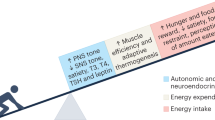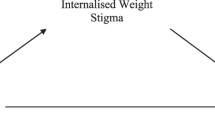Abstract
Background:
Many obese individuals lose weight to reduce weight stigma; however, little is known about whether other people's attitudes actually improve towards obese individuals after they have lost weight, and whether changes in attitudes depend on the method of weight loss. This study examined changes in people's perceptions of an obese target who had lost weight through diet and exercise or through surgery.
Method:
Participants (N=73) initially viewed an image of an obese woman or a thin woman (control condition), and were asked to indicate their perceptions of the target with respect to the target's behaviors (for example, how often she exercises), as well as some personality characteristics (for example, lazy, sloppy and competent). Participants then viewed a more recent image of the target in which she had lost weight, and were informed that the target had lost weight through diet and exercise or through surgery, or were not provided with any explanation for the weight loss. Participants once again indicated their impression of the target on the same measures.
Results:
Regardless of the method of weight loss, all targets were rated as eating more healthily, exercising more, and being more competent and less sloppy after having lost weight. Participants also rated the target as less lazy when they learned that she had lost weight through diet and exercise, or when no information was provided about the method of weight loss; the target who lost weight through surgery, however, was not seen as being any less lazy after losing weight.
Conclusion:
These findings indicate that perceptions of obese individuals can in fact improve after they have lost weight, but that this might depend on the method of weight loss.
This is a preview of subscription content, access via your institution
Access options
Subscribe to this journal
Receive 12 print issues and online access
$259.00 per year
only $21.58 per issue
Buy this article
- Purchase on Springer Link
- Instant access to full article PDF
Prices may be subject to local taxes which are calculated during checkout
Similar content being viewed by others
References
Ogden CL, Carroll MD, Curtin LR, McDowell MA, Tabak CJ, Flegal KM . Prevalence of overweight and obesity in the United States, 1999–2004. JAMA 2006; 295: 1549–1555.
Australian Bureau of Statistics. National health survey: summary of results, 2007-2008 (Reissue). Retrieved from http://www.abs.gov.au/ausstats/abs@.nsf/mf/4364.0, 2009.
Australian Bureau of Statistics. Smoking, risky drinking and obesity. Retrieved from http://www.abs.gov.au/AUSSTATS/abs@.nsf/Lookup/4102.0Main+Features30Dec+2009, 2009.
Puhl RM, Heuer CA . The stigma of obesity: a review and update. Obesity 2009; 17: 941–964.
Puhl R, Brownell KD . Bias, discrimination, and obesity. Obes Res 2001; 9: 788–805.
Crandall CS . Prejudice against fat people: ideology and self-interest. J Pers Soc Psychol 1994; 66: 882–894.
Teachman BA, Gapinski KD, Brownell KD, Rawlins M, Jeyaram S . Demonstrations of implicit anti-fat bias: the impact of providing causal information and evoking empathy. Health Psychol 2003; 22: 68–78.
Hilbert A, Rief W, Braehler E . Stigmatizing attitudes toward obesity in a representative population-based sample. Obesity 2008; 16: 1529–1534.
Penny H, Haddock G . Anti-fat prejudice among children: the ‘mere proximity’ effect in 5–10 year olds. J Exp Soc Psychol 2007; 43: 678–683.
Brown I . Nurses’ attitudes towards adult patients who are obese: Literature review. J Adv Nurs 2006; 53: 221–232.
Jay M, Kalet A, Ark T, McMacken M, Messito MJ, Richter R et al. Physicians’ attitudes about obesity and their associations with competency and specialty: A cross-sectional study. BMC Health Serv Res 2009; 9: 106–117.
Schwartz MB, Vartanian LR, Nosek BA, Brownell KD . The influence of one's own body weight on implicit and explicit anti-fat bias. Obesity 2006; 14: 440–447.
Goldstein DJ . Beneficial health effects of modest weight loss. Int J Obes Relat Metab Disord 1992; 16: 397–415.
Oster G, Thompson D, Edelsberg J, Bird AP, Colditz GA . Lifetime health and economic benefits of weight loss among obese persons. Am J Public Health 1999; 89: 1536–1542.
Geier AB, Schwartz MB, Brownell KD . ‘Before and after’ diet advertisements escalate weight stigma. Eating Weight Dis 2003; 8: 282–288.
Blaine BE, DiBlasi DM, Connor JM . The effect of weight loss on perceptions of weight controllability: implications for prejudice against overweight people. J Appl Biobehav Res 2002; 7: 44–56.
Christopher AN, Morgan RD, Marek P, Troisi JD, Jones JR, Reinhart DF . Affluence cues and first impressions: does it matter how the affluence was acquired? J Econ Psychol 2005; 26: 187–200.
O’Brien PE, Sawyer SM, Laurie C, Brown WA, Skinner S, Veit F et al. Laparoscopic adjustable gastric banding in severely obese adolescents: a randomized trial. JAMA 2010; 303: 519–526.
Shabbir A, Loi TH, Lomanto D, Ti TK, So JBY . Surgical management of obesity: National university hospital experience. Annals Acad Med Singapore 2009; 38: 882–890.
Peace K, Dyne J, Russell G, Stewart R . Psychological effects of gastric restriction surgery for morbid obesity. New Zeal Med J 1989; 102: 76–78.
Kral JG, Sjöström LV, Sullivan MBE . Assessment of quality of life before and after surgery for severe obesity. Am J Clin Nutr 1992; 55: 611S–614S.
Rand CW, MacGregor AMC . Morbidly obese patients’ perceptions of social discrimination before and after surgery for obesity. South Med J 1990; 83: 1390–1395.
Vallis TM, Butler GS, Perey B, van Zanten SJO, MacDonald AS, Konok G . The role of psychological functioning in morbid obesity and its treatment with gastroplasty. Obes Surgery 2001; 11: 716–725.
Mattingly BA, Stambush MA, Hill AE . Shedding the pounds but not the stigma: negative attributions as a function of a target's method of weight loss. J Appl Biobehav Res 2009; 14: 128–144.
Fiske ST, Cuddy AC, Glick P, Xu J . A model of (often mixed) stereotype content: competence and warmth follow from perceived status and competition. J Pers Soc Psychol 2002; 82: 878–902.
Tiggemann M, Rothblum ED . Gender differences in social consequences of perceived overweight in the United States and Australia. Sex Roles 1988; 18: 75–86.
Vartanian LR, Silverstein KM . Obesity as a status cue: perceived social status and the stereotypes of obese individuals (submitted for publication).
Author information
Authors and Affiliations
Corresponding author
Ethics declarations
Competing interests
The authors declare no conflict of interest.
Rights and permissions
About this article
Cite this article
Fardouly, J., Vartanian, L. Changes in weight bias following weight loss: the impact of weight-loss method. Int J Obes 36, 314–319 (2012). https://doi.org/10.1038/ijo.2011.26
Received:
Accepted:
Published:
Issue Date:
DOI: https://doi.org/10.1038/ijo.2011.26
Keywords
This article is cited by
-
Zuweisungsverhalten der Hausärzte bei Patienten mit Adipositas
Der Chirurg (2018)
-
Patient and Parent Perspectives of Adolescent Laparoscopic Adjustable Gastric Banding (LAGB)
Obesity Surgery (2016)
-
Changes in Weight Bias and Perceived Employability Following Weight Loss and Gain
Obesity Surgery (2015)
-
The Stigma of Obesity Surgery: Negative Evaluations Based on Weight Loss History
Obesity Surgery (2013)
-
Primum Non Nocere: Obesity Stigma and Public Health
Journal of Bioethical Inquiry (2013)



